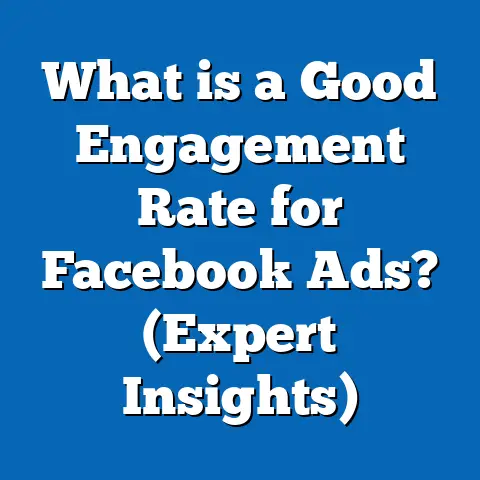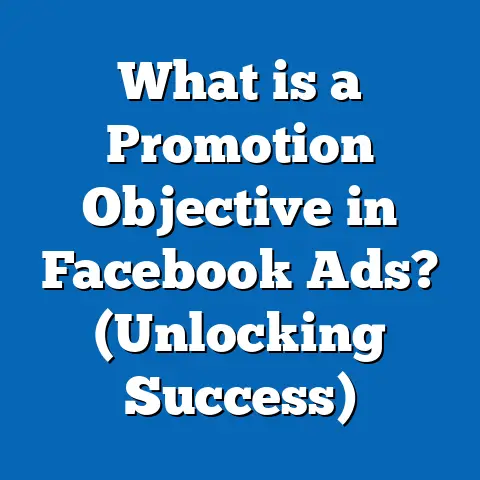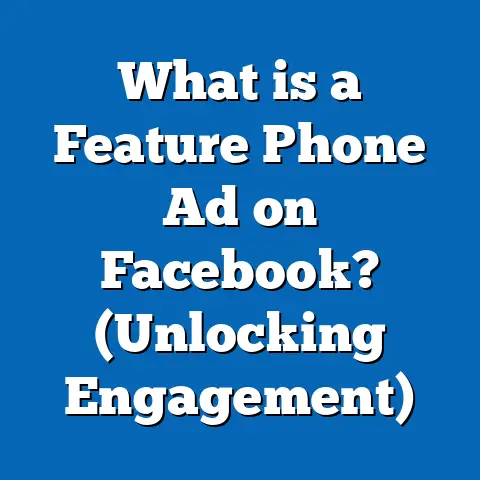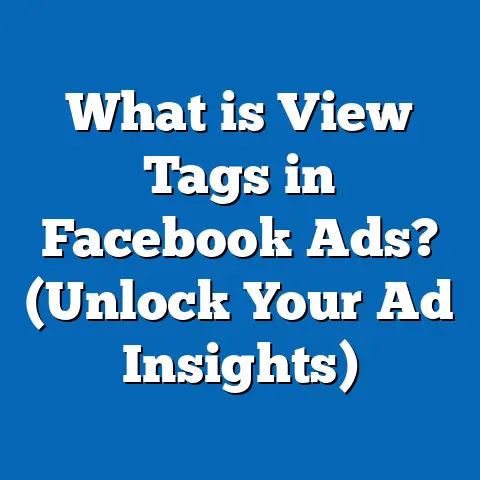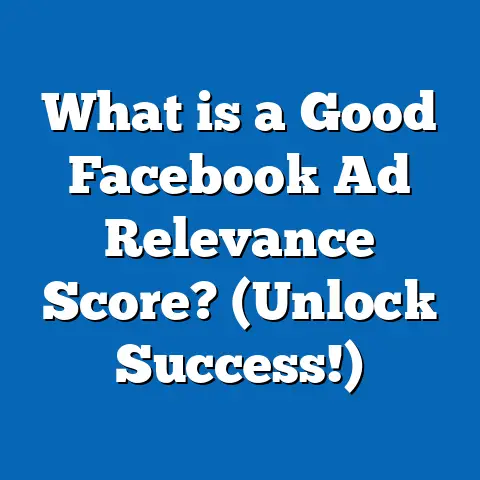What is Estimated Ad Recall Lift? (Unlocking Ad Effectiveness)
What is Estimated Ad Recall Lift? (Unlocking Ad Effectiveness)
Introduction: The Key to Measuring Ad Impact Beyond Clicks
Digital advertising is evolving rapidly. While traditional metrics like clicks and conversions remain important, they only capture immediate reactions. What about the ads that leave a lasting impression—those that influence consumer decisions days or even weeks later? This is where Estimated Ad Recall Lift (EARL) becomes a game-changer.
EARL measures how many people are likely to remember your ad shortly after viewing it. This insight is critical in understanding your ads’ true effectiveness in building brand awareness and influencing future behavior. For marketers and business owners, mastering EARL means unlocking deeper insights into your campaigns, optimizing for long-term impact, and making smarter budget decisions.
Understanding Estimated Ad Recall Lift
What is Estimated Ad Recall Lift?
Estimated Ad Recall Lift is a proprietary Facebook metric that estimates how many people would remember seeing your ad if asked within two days after exposure. This goes beyond surface-level data such as clicks or impressions by focusing on the ad’s memorability—a critical component for effective brand advertising.
Facebook uses a combination of survey data and advanced statistical models to calculate EARL. This allows advertisers to see an estimate of how many additional people recall their ad due to the campaign compared to a control group who did not see the ad.
Unlike direct response metrics, EARL captures the subtle but powerful influence of advertising on consumer memory and brand perception.
Why EARL Matters for Advertisers
- Measures Brand Impact Beyond Immediate Actions: Many users don’t click ads upon first exposure but may remember them later when making purchasing decisions.
- Helps Optimize Campaigns for Awareness: EARL identifies which creative elements or targeting strategies make ads more memorable.
- Supports Holistic Marketing Evaluation: Combines with other metrics like CTR and conversions for a full picture of ad effectiveness.
- Improves Long-Term Brand Equity: Sustained ad recall builds familiarity and trust, leading to higher customer lifetime value.
- Enables Smarter Budget Allocation: Focus resources on ads driving the highest recall lift for better ROI.
How EARL Differs from Other Metrics
Understanding how EARL fits into the marketing analytics landscape helps marketers make more informed decisions. Here’s a detailed comparison:
| Metric | What It Measures | Timeframe | Focus | Pros | Cons |
|---|---|---|---|---|---|
| Click-Through Rate (CTR) | Immediate clicks on the ad | Instant | Direct engagement | Clear, actionable | Only shows short-term action |
| Impressions | Number of times ad was shown | Instant | Exposure | Measures reach | Doesn’t indicate impact |
| Reach | Number of unique users who saw the ad | Instant | Audience size | Useful for audience sizing | Doesn’t measure engagement |
| Estimated Ad Recall Lift | Estimated number who remember seeing ad | Within 2 days | Memorability & brand recall | Captures deeper brand impact | Requires surveys/modeling |
How Facebook Calculates Estimated Ad Recall Lift
Survey-Based Model
Facebook’s approach to measuring ad recall is grounded in primary research. They randomly survey users exposed to an ad and ask if they remember seeing it. The question is typically framed as:
“Do you recall seeing an ad for [Brand/Product] in the last two days?”
The responses form a baseline for ad recall rates among exposed users.
Statistical Modeling
To extend results beyond surveyed users, Facebook employs sophisticated statistical modeling techniques:
- Control Groups: Facebook creates control groups of users who did not see the ad. Their recall rates serve as a baseline to adjust for natural brand awareness.
- Incremental Lift Calculation: The difference between recall rates of exposed users and control groups estimates the incremental lift caused by the ad.
- Regression Models: These models account for variables such as demographics, frequency of exposure, and engagement signals.
- Machine Learning Algorithms: Used to predict recall rates across non-surveyed audiences based on observed data patterns.
Data Inputs Facebook Uses:
- Frequency of ad exposure
- Demographics of viewers (age, gender, location)
- Device type and platform
- Ad placement and formats (news feed, stories, etc.)
- User engagement signals (likes, shares, comments)
- Survey responses from sampled users
This combination ensures that EARL reflects a statistically valid estimate of ad recall across your entire audience.
The Science Behind Ad Recall: Why It Matters
The Role of Memory in Advertising
Advertising’s ultimate goal is to influence consumer behavior. Often, purchase decisions aren’t made immediately but after repeated exposures and reflections. Consumer memory is crucial in this process:
- Top-of-Mind Awareness: Brands that are easily recalled are more likely to be chosen.
- Emotional Connection: Memorable ads evoke feelings, increasing attachment.
- Reinforcement Effect: Repeated exposure strengthens memory encoding.
Ad recall measures how well an advertisement succeeds in embedding itself in consumer memory, which strongly correlates with brand preference and sales.
Studies Supporting Ad Recall’s Influence
Several studies highlight the importance of ad recall:
- Nielsen’s Brand Effectiveness Study found that campaigns optimized for brand awareness generated a 23% higher purchase intent compared to those focused solely on clicks.
- A Facebook-commissioned study revealed that ads with higher EARL correlated with a lift in sales by up to 12%, underscoring the link between memorability and actual revenue impact.
- According to research published by Harvard Business Review, memorable ads improve brand equity, fostering customer loyalty and sustained growth.
Detailed Breakdown: Factors Influencing Estimated Ad Recall Lift
1. Frequency of Exposure
Frequency refers to how many times a user sees your ad. There’s a sweet spot:
- Too few impressions lead to low recall due to insufficient exposure.
- Too many impressions cause fatigue or annoyance, lowering positive recall.
Research suggests an optimal frequency range of 3–5 exposures per user maximizes memorability without overwhelming viewers.
2. Creative Format
Different ad formats impact recall differently:
- Video Ads: Engage multiple senses and storytelling elements; can increase recall by up to 30% over static images.
- Carousel Ads: Allow showcasing multiple products or features; improve engagement and retention.
- Static Images: Often less memorable unless highly creative or emotionally appealing.
3. Messaging & Emotional Appeal
Ads that trigger emotions or tell compelling stories are more likely to be remembered. Emotional resonance aids memory encoding through stronger neural connections.
4. Audience Targeting
Precision targeting ensures ads reach users most likely to engage and recall messaging. Broad targeting may reduce average recall rates due to lower relevancy.
5. Brand Consistency
Using consistent logos, colors, taglines, and tone helps reinforce brand identity and improves recognition and recall.
Practical Insights Into Using Estimated Ad Recall Lift
When Should You Use EARL?
EARL provides value across various campaign types:
- Brand Awareness Campaigns: To gauge if your message sticks with target audiences.
- New Product Launches: Measure initial penetration and interest levels.
- Creative Testing: Identify which creatives generate the highest recall before scaling.
- Cross-Channel Attribution: Understand Facebook’s contribution to overall brand lift alongside TV or other digital channels.
How to Access EARL Data
EARL data is available primarily through:
- Facebook Ads Manager under “Brand Awareness” campaign objectives.
- Facebook Brand Lift studies (more granular insights).
- Custom reports combining EARL with other KPIs.
Interpreting EARL Results Correctly
- A positive EARL indicates your campaign increased ad recall compared to baseline awareness.
- Compare EARL across different audience segments to refine targeting.
- Monitor EARL over time as an indicator of creative freshness—declining recall suggests creative fatigue.
Case Studies Demonstrating EARL Impact
Case Study 1: E-Commerce Brand Boosts Recall by 35%
An online apparel retailer ran parallel campaigns: one focused on maximizing clicks, another on increasing ad recall. The EARL-focused campaign increased estimated recall by 35%, which led to a 20% rise in branded search volume within two weeks. This uplift translated into higher sales down the funnel.
Key takeaway: Prioritizing memorability drives stronger brand interest that precedes conversions.
Case Study 2: Consumer Electronics Company Tests Creative Variations
A tech firm tested three video ads with different messaging approaches: product features, customer testimonials, and emotional storytelling. The storytelling ad delivered an EARL 40% higher than the others. This aligned with a 15% increase in trial sign-ups post-campaign.
Key takeaway: Emotional narratives create more memorable experiences that fuel downstream actions.
Case Study 3: Restaurant Chain Increases Reach & Recall Simultaneously
A regional restaurant chain combined geotargeting with dynamic video ads optimized for EARL. They achieved a 28% lift in estimated ad recall among local audiences while maintaining efficient cost-per-thousand impressions (CPM).
Key takeaway: Localized targeting combined with engaging content can maximize both reach and memorability.
Advanced Strategies for Maximizing Estimated Ad Recall Lift
1. Optimize Frequency Without Overexposure
Managing frequency is critical. Use frequency capping tools in Facebook Ads Manager to limit exposures per user between 3 and 5 times depending on campaign goals.
2. Use Engaging Formats Strategically
Prioritize rich media such as video or carousel ads for campaigns focused on awareness. Utilize interactive elements like polls or augmented reality when possible.
3. Target Precisely & Segment Audiences
Create audience segments based on behaviors, interests, or past engagement levels. Tailor messaging specifically to these groups for higher relevancy and recall.
4. Incorporate Strong Brand Elements Consistently
Maintain brand consistency across all creatives—logos should be visible early in videos; colors should align with brand guidelines; taglines should be memorable and repeated.
5. Test & Iterate Creatives Based on EARL Data
Use Brand Lift studies and Ads Manager reports to identify high-performing creatives. Pause or refresh underperforming ads quickly based on declining recall metrics.
Comparing EARL to Other Platforms’ Brand Lift Metrics
| Platform | Brand Lift Metric Name | Methodology | Availability | Unique Strengths |
|---|---|---|---|---|
| Estimated Ad Recall Lift | Sponsored surveys + modeling | Via Ads Manager & Brand Lift | Large user base; advanced modeling | |
| Google Ads | Brand Lift Study | Surveys + control groups | Google Ads platform | Integrates video & search data |
| YouTube | Brand Lift Measurement | Surveys + experimental design | Google Ads & YouTube analytics | Video-first platform; rich engagement data |
| Brand Awareness & Recall Metrics | Poll-based surveys | LinkedIn Campaign Manager | Professional audience focus |
Facebook’s EARL stands out due to its vast user base and sophisticated machine learning models that deliver statistically significant estimates quickly.
Key Statistics on Estimated Ad Recall Lift Effectiveness
- Brands using EARL optimization have reported a 15% improvement in overall campaign ROI (based on Facebook internal research).
- Video ads on Facebook can increase EARL by up to 30% compared to static images.
- Campaigns optimized using EARL insights see an average boost of 10–25% in key brand awareness KPIs.
- Facebook surveys over 10 million users monthly for brand lift studies ensuring robust data quality.
- Advertisers who balance frequency efficiently report up to a 50% increase in positive brand sentiment measured via surveys linked with EARL.
How to Implement EARL Insights into Your Marketing Strategy
- Set Clear Awareness Goals: Define specific targets for estimated ad recall lift before launching campaigns.
- Run Brand Lift Studies Alongside Campaigns: Complement daily Ads Manager monitoring with formal studies for granular insights.
- Analyze EARL by Audience Segment: Break down results by demographics, geography, device type, placement, etc., for targeted adjustments.
- Adjust Frequency & Creative Based on Data: Use results to optimize frequency caps or refresh creatives proactively.
- Integrate Recall Insights with Sales & Conversion Metrics: Correlate recall lift with downstream performance for holistic evaluation.
- Use Learnings for Cross-Channel Planning: Apply insights from Facebook EARL metrics when planning TV or offline advertising campaigns.
- Educate Your Team & Stakeholders: Share findings internally to align marketing objectives around brand impact rather than just direct response.
Common Challenges and Solutions with EARL
| Challenge | Solution |
|---|---|
| Limited access without Brand Lift program | Invest strategically in Brand Lift studies; start small |
| Complexity interpreting results | Use clear benchmarks; combine qualitative insights from surveys |
| Survey bias or sample limitations | Combine with other brand metrics like NPS or social listening |
| Balancing recall focus with direct response goals | Run split tests combining awareness & conversion objectives |
| Managing frequency effectively | Use automated frequency capping tools; monitor fatigue signs |
Future Trends in Ad Recall Measurement
The landscape of measuring ad memorability continues evolving:
- Greater use of AI/ML will provide more personalized recall predictions at scale.
- Cross-device tracking will improve attribution accuracy across phones, tablets, desktops.
- Psychographic data integration will allow better understanding of emotional drivers behind recall.
- Real-time recall measurement will enable dynamic creative optimization during campaigns.
- Integration with augmented reality (AR) and virtual reality (VR) advertising may open new frontiers for immersive brand experiences with high memorability potential.
Summary: Unlocking True Ad Effectiveness with Estimated Ad Recall Lift
Estimated Ad Recall Lift offers marketing professionals a critical lens into how well their Facebook ads resonate beyond immediate clicks and impressions. It reveals the hidden power of memorability—how advertising stays top-of-mind and influences future choices.
By incorporating EARL into your measurement toolkit you gain the ability to:
- Optimize creatives for emotional resonance and brand consistency
- Target audiences more precisely for maximum relevance
- Manage frequency intelligently to avoid fatigue
- Justify brand awareness investments with data-backed evidence
- Integrate insights with overall marketing performance for strategic planning
Next Steps: Begin leveraging Facebook’s Brand Lift studies today, experiment with video storytelling formats, monitor EARL trends closely, and align your campaigns around long-term brand growth—not just short-term clicks.
If you want detailed guidance on setting up Brand Lift studies or need help analyzing your current campaigns’ Estimated Ad Recall Lift data tailored specifically for your industry or business size, I’m ready to assist further.

